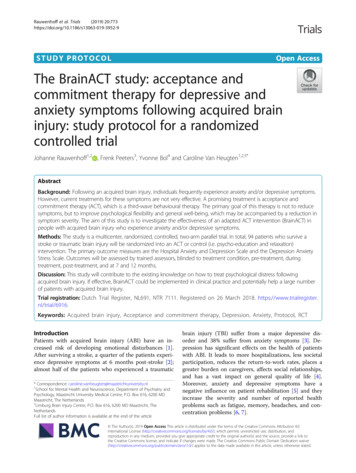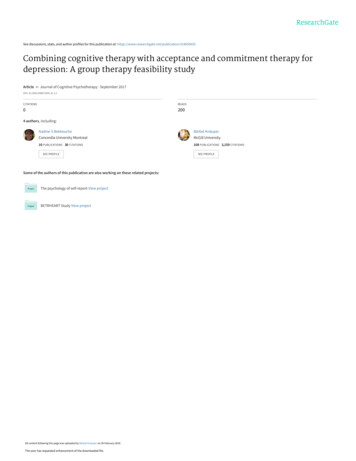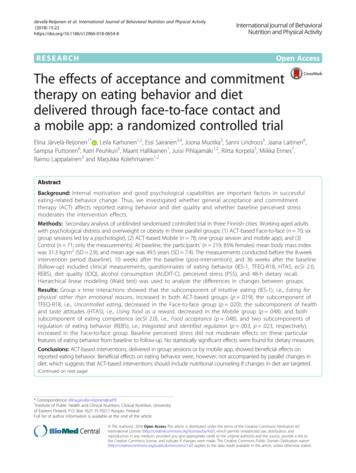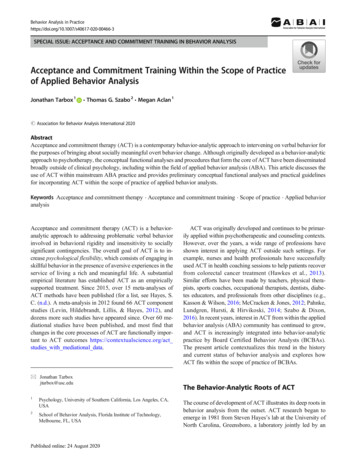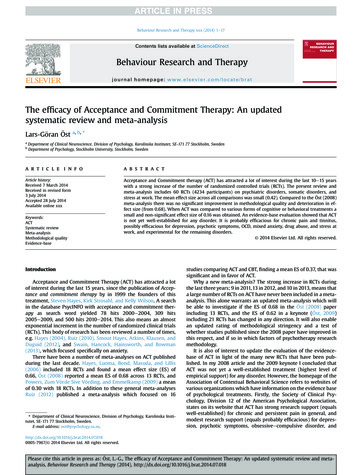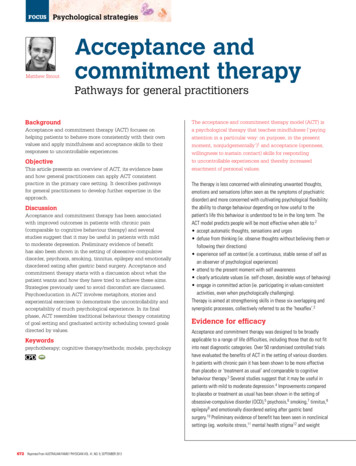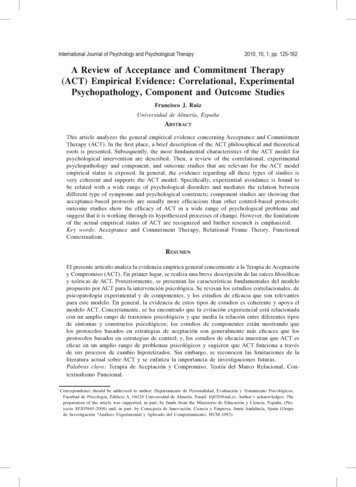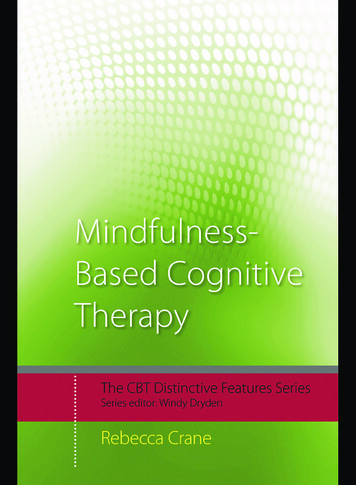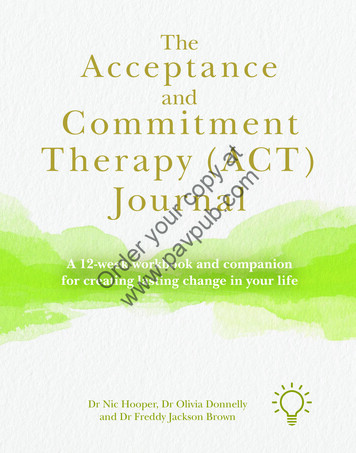
Transcription
TheA ccept a nceandOw rdew rw yo.p uav r cpu opb. yco atmC omm it mentT her a py (AC T )Jou r na lA 12-week workbook and companionfor creating lasting change in your lifeDr Nic Hooper, Dr Olivia Donnellyand Dr Freddy Jackson Brown
The Acceptance and Commitment Therapy (ACT)Journal Pavilion Publishing and Media 2021With many thanks to Fiona O’Neill for sourcingthe beautiful quotations found within this journalThe authors have asserted their rights in accordance with the Copyright, Designs andPatents Act (1988) to be identified as the authors of this work.Published 2021Orw dew rw yo.p uav r cpu opb. yco atmPublished by:Pavilion Publishing and Media LtdBlue Sky OfficesCecil Pashley WayShoreham-by-SeaWest SussexBN43 5FFTel: 01273 434 943Fax: 01273 227 308Email: info@pavpub.comAll rights reserved. No part of this publication may be reproduced, stored in aretrieval system, or transmitted in any form or by any means, electronic, mechanical,photocopying, recording or otherwise, without prior permission in writing of thepublisher and the copyright owners.A catalogue record for this book is available from the British Library.ISBN: 978-1-912755-78-3Pavilion Publishing and Media is a leading publisher of books, training materials anddigital content in mental health, social care and allied fields. Pavilion and its imprintsoffer must-have knowledge and innovative learning solutions underpinned by soundresearch and professional values.Editor: Ruth Chalmers, Pavilion Publishing and Media Ltd.Cover design: Phil Morash, Pavilion Publishing and Media Ltd.Page layout and typesetting: Phil Morash, Pavilion Publishing and Media Ltd.Printing: Ashford Press
Week 1: Choosing WiselyWeek commencing: .Welcome to Week 1.Orw dew rw yo.p uav r cpu opb. yco atmThe first few weeks of the journal are going to have a little more contentthan the later weeks. Our reasoning is that if we give you enoughinformation early on in our journey together then this should lay a strongfoundation for what comes after.
Introducing Your Key Tool For CreatingPowerful ChangeOrw dew rw yo.p uav r cpu opb. yco atmWe’re hopeful that you now have a basic understanding of what the ACTmodel is all about. However, there’s a chance that it feels very abstract,or even a little like ‘psychobabble’. Therefore, the time has come to makeeverything more real and more useful by introducing you to your key toolfor making powerful changes. It’s called The Choice Point.
Week 1: Choosing WiselyThe Choice PointTowardsookedkedUnhHooOrw dew rw yo.p uav r cpu opb. yco atmAwaySituation(s)Thoughts & Feelings
On the page opposite you can see a diagram representing The ChoicePoint. This is your key tool for creating powerful change in your life. LikeThe Triflex, The Choice Point has been taken from the wonderful work ofDr Russ Harris in his landmark book ACT Made Simple (2nd edition). Let ustalk you through it.Orw dew rw yo.p uav r cpu opb. yco atmFirstly, direct your attention to the ‘towards’ arrow. This arrow representsall the things we do in our life that bring us fulfilment or energy. Whenwe make ‘towards-moves’ we’re acting under the influence of what’simportant to us and being the sort of person we want to be.Let’s give a straightforward example of a towards-move:Imagine that whilst on our driveway we see a neighbour across theroad struggling to take shopping from their car to their house, andthat being kind is an important quality for us. A ‘towards-move’ herewould be crossing the road and offering to help carry the shopping.Towards-moves, therefore, are basically the behaviours that we want todo more of, and they help us to grow. However, in life, there are plentyof times when we make ‘away-moves’. You can see these away-movesrepresented by the ‘away’ arrow in the diagram. Doing this takes us awayfrom the sort of life we’d like to be living and the sort of person we’d like tobe. An away-move in our example might look like this:Imagine that we saw the neighbour struggling and ignored it.We quickly shuffled into our house hoping that they didn’t notice us.
Week 1: Choosing WiselyOur days are filled with towards-moves and away-moves. When life isgoing well, the towards-moves are easier to choose. As an example, whenour buckets aren’t full of the stresses and strains of life, sticking to anexercise regime is a lot easier!Orw dew rw yo.p uav r cpu opb. yco atmHowever, often our buckets are not empty. Life is complex, and thismeans that sometimes, as we move toward the things that are importantto us, difficult thoughts and feelings can show up. You can see theserepresented at the bottom of the diagram. These thoughts and feelingscan ‘hook’ us, and when we’re hooked with difficult thoughts and feelings,we’re more likely to make away-moves. Our example can help us tounderstand this idea of being hooked:Whilst on our driveway, we may feel socially anxious at thethought of approaching the neighbour and our minds mayfeed us thoughts like, “They’ll probably be embarrassed and feelawkward if I go over there” or “I’m busy now, I’ll help next time”.As a result of these tricky thoughts and feelings we choose not tohelp our neighbour.Now, being hooked and then making away-moves doesn’t matter toomuch a lot of the time (for example, the neighbour will probably be ok,and we probably won’t feel too bad about it). However, if it happenscontinually, and in lots of different situations, then we’ll have big problems.In fact, most psychological troubles develop because of this process: weget hooked by tricky thoughts and feelings and start making away-movesas a way to try and manage them. This works in the short term (we tend tofeel enormous relief), but avoidance makes life smaller in the longer term.But don’t despair – it’s possible to ‘unhook’ from difficult thoughts andfeelings. And if we can unhook from them, then we’ll be able to get onwith doing things that move us towards the sort of life that we want, andtowards the sort of person we’d like to be.
So a lot of what ACT is about is using some of the basic skills wementioned earlier to ‘unhook’ from difficult thoughts and feelings. If wecan manage to develop these skills, then we may be able to make betterdecisions when we’re at a choice point. Back to our example:On our driveway we were at a choice point. Our values were pullingus to make a towards-move, and we had some tricky thoughts andfeelings trying to hook us into an away-move.Orw dew rw yo.p uav r cpu opb. yco atmWe have multiple choice points throughout our days. Your ACT Journal willhelp you to cut back on away-moves, and to make more towards-movesby unhooking from tricky thoughts and feelings. In other words, you’lllearn to use ACT to create a space where you can choose a richer, wiserresponse, especially in challenging situations.
Week 1: Choosing WiselyValuesBefore we can start to apply the choice point to our lives, we need to havea clearer picture of what a towards-move might look like for us. In otherwords, we need to figure out what our values are and what directions wewant our life to be moving in. This journal is going to give you plenty ofopportunity to think about these things, starting right now.Orw dew rw yo.p uav r cpu opb. yco atmIn ACT, values are about how you want to behave, moment-by-moment,during your life. In some ways, they describe the sort of person you want tobe, or the sort of qualities you’d like to bring to your daily actions.For example, if the value of caring is important to you then what can youdo that reflects this value? How can you behave towards yourself, othersand the environment in a caring way? Interestingly, in some situationsyou might actually feel frustrated or impatient, but you can nonethelesschoose to behave in a caring way.We’d like you to get an early impression of which values you hold dear.Therefore, opposite you’ll find a list of common values. For now, we’dsimply like you to cross out boxes until you have the three most importantvalues left (do this with a pencil so that you can use the list as a referencepoint for the rest of the journal).
ientAssertiveForgivingRespectfulOrw dew rw yo.p uav r cpu opb. yco eousIndependentWrite your ownCreativeIntimateWrite your ownSelf disciplinedKindWrite your ownCuriousLovingWrite your own
Week 1: Choosing WiselyNow that you have a basic idea of what’s meant by the word ‘values’(i.e. qualities that we’d like to bring to our behaviours) we need to tell yousomething else about them. Specifically, values change depending onthe context or the domain, and some domains in our life are importantwhile others are less so. We’d now like you to complete the exercise on thefollowing page, as it will give you a baseline idea of the domains in your lifethat are most important.Orw dew rw yo.p uav r cpu opb. yco atmPlease note that it’s natural for some discomfort to show up during thisexercise, especially if you notice a gap between where you are right nowand where you want to be, but try to be as honest as possible. Your ACTJournal is tailored to help you bridge any gaps that emerge, and we’llrepeat this exercise at the end of the journal to illustrate the progressyou’ve made.Right, on with the exercise: In column 2, rate the importance of the domain in question, on a scaleof 1-10. In column 3, rate how much time you spend in that domain (i.e. theamount of attention or action you give it), again on a scale of 1-10. In column 4, subtract the smaller number from the larger to createa ‘concern’ score for each domain.
1 Min; 10 MaxValued domainOverallImportance(1-10)Action (1-10)1. Friends / SocialRelationships2. FamilyRelationshipsOrw dew rw yo.p uav r cpu opb. yco atm3. IntimateRelationships4. Work / Career/ Finance5. Education /Learning6. Growth / SelfDevelopment7. Recreation /Leisure8. Spirituality9. Citizenship /Community10. Health /Physical WellBeingConcern (1-10)
Week 1: Choosing WiselyCommitted ActionValues mean nothing if you don’t bring them to life with your actions. Inother words, we need some concrete goals (short-term and long-term)that are in lines with our values, which we commit to act on. An examplemight be something like this:Orw dew rw yo.p uav r cpu opb. yco atmIf I wanted to bring a value of ‘connection’ to life, then I may write thefollowing entry into my journal: “On Wednesday morning at 10am,I will send an email to Jane, as I haven’t spoken to her for a while andI value my friendship with her.”Committed action is all about setting goals that are in line with values.However, when you set goals, making them SMART (Specific, Measurable,Achievable, Relevant/Rewarding and Time-based) will increase thechances of you actually completing them:Specific:This is about being as precise as possible with regards to what you wantto achieve. The more specific your description, the easier it is to know ifyou achieved it.Measurable:This is about setting goals you can measure so that you know when youhave achieved them.Achievable:Is your goal really achievable? Setting goals that are unrealistic or along way in the future makes life difficult. If you have a large goal, thenit’s better to break it down into smaller steps. A good rule of thumb isif you’re less than 70% confident you’ll act on your values-based goal,break it down into something more manageable.
Relevant:This is about checking that the goal really reflects your underlyingvalues. It’s quite common to set goals that we think we ‘should’ do,but deep down we may not really care about them.Time-based:This is about being clear when you’ll complete your goal. It’s importantto be precise about this.Orw dew rw yo.p uav r cpu opb. yco atmExample of a SMART goal:SMy goal is to read 3 books about the history of art (specific).MI will read every night for 30 minutes (measurable).AThis is possible within my daily routine (achievable).RThe goal is important to me because I value learning (relevant).TI will complete this goal within 2 months (time-based).
The Acceptance and Commitment Therapy (ACT) Journal A 12-week workbook and companion for creating lasting change in your life Dr Nic Hooper, Dr Olivia Donnelly and Dr Freddy Jackson Brown The Acceptance and Commitment Therapy (ACT) Journal Order your copy at www.pavpub.com.

